Severe but highly variable wind damage to homes & infrastructure is a hallmark of intense tropical cyclones. Until recently there was only speculation that such damage, which appears in short swaths, was the work of tornadoes. Now, there’s first-ever proof that tornadoes and other small-scale phenomena did indeed enhance the winds and damage in Hurricane Harvey last August.
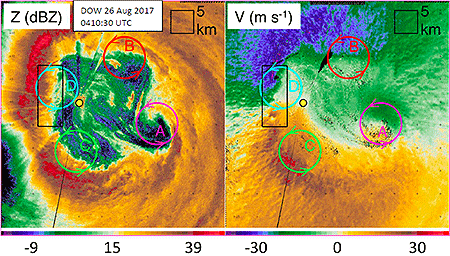
Doppler of Wheels (DOW) radar in the eye of Harvey revealed mesovortices (MVs) rotating swiftly around the inner eyewall, and embedded in them and documented for the first time were small tornado-scale-vortices (TSVs) less than a half-mile wide spinning within the larger wind field of the hurricane. The discovery was reported in March in a paper published in Monthly Weather Review.
The rotation of the TSVs is weaker than typical supercell tornadoes, but because these circulating winds are embedded in an already extreme eyewall, they ramp up the wind speed and create greatly enhanced damage potential, says the study’s lead author Joshua Wurman of the Center for Severe Weather Research. In Harvey, major hurricane winds of about 120 mph ramped up to 130-140 mph or more and resulted in streaks of severe damage not evident elsewhere from the eyewall winds.
“Wind gusts at the DOW site were measured up to 145 mph, likely caused by a TSV, and 30% of the vehicles parked near the DOW were lofted,” Wurman wrote in a summary of the paper to appear in a forthcoming issue of the Bulletin of the AMS. A Jeep and two SUVs were picked up by the wind and landed atop debris from the destroyed building in which they were housed. He said the swaths of intense damage corresponded to the tracks of the eyewall TSVs.
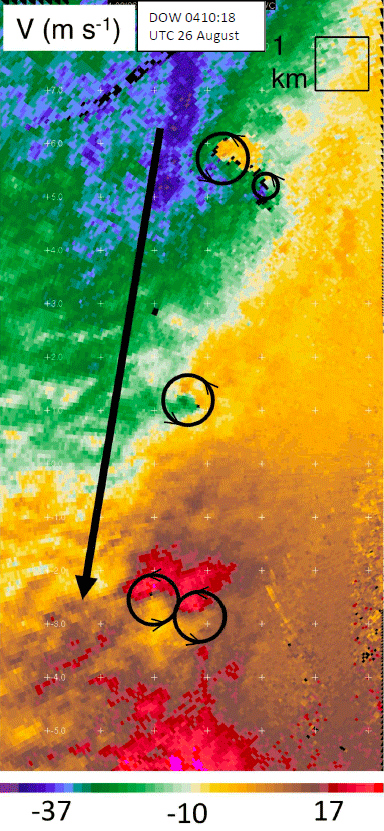
Doppler velocity data reveals single and paired TSVs (black circles) translating southward in Harvey’s northwestern eyewall embedded in strong northerly flow (black arrow). These TSVs, moving southward at up to 120 mph, were associated with very intense winds measured up to 145 mph, lofted vehicles, and swaths of the most intense building damage.
Wurman and co-author Karen Kosiba, also with CSWR, will present their research findings from Hurricane Harvey as well as newly identified evidence of at least one Harvey-like TSV in Hurricane Irma over Florida at the 33rd AMS Conference on Hurricanes and Tropical Meteorology next week in Ponte Vedra Beach, Florida. The conference will feature a number of other presentations on the devastating hurricanes of 2017, in multiple sessions (Session 1, Session 2, Session 3, Session 4).
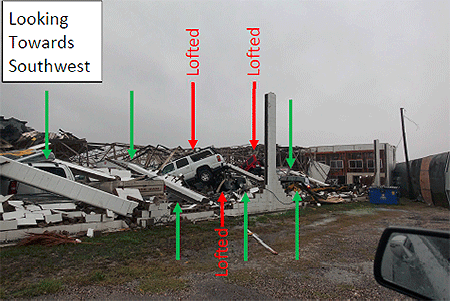
Wurman notes that it’s unclear whether the new wind whirls are more numerous in intense or rapidly strengthening hurricanes. But adds that the enhanced damage was palpable, and with an increase in powerful hurricanes possible due to rising global air and ocean temperatures, it’s important to learn more about them, he says.
“Potential climate change may result in more frequent intense and/or rapidly intensifying hurricanes, thus understanding and forecasting the causes of hurricane wind damage is a high priority.”
hurricanes
Did You Hear? Echoes from the Annual Meeting
This year’s AMS Annual Meeting provided no shortage of memorable presentations. The focus on 2017’s hurricanes in particular yielded some of the most memorable moments, and now you can listen (again, or for the first time) for yourself. Recorded presentations are being uploaded gradually to the AMS meeting program site.
Richard Alley’s speech at the Presidential Forum was the first to go online, here including AMS President Roger Wakimoto’s introduction as well as questions from the audience:
Here’s a portion of Dr. Alley’s memorable riff on our semi-aware relationship to the science and technology we carry around in our pockets every day:
I’m a Newtonian physicist. I didn’t take quantum, I didn’t take relativity. But my understand is that the nice lady in the (cell) phone using the GPS is using both general and special relativity. Because down here, she is deeper in Earth’s gravity well and she is moving slower than the clocks on the satellite. And the correction from relativity is about 10 km a day. And she can do 10 km pretty easily. Which means if she didn’t have relativity, she would get lost in about two minutes. And that’s … We get where we’re going not only because of quantum mechanics but also because of Einstein. And, no, she will not fall for you because she’s canoodling with Einstein in the phone here.
But you know how these things work. Right? … I’ve been working on ice since 1977, the summer after my freshman year. My teachers, in geology and other things, I think if you were to ask them what is the most useless and esoteric science you can think of, they might have said relativity and quantum mechanics. And you’ve got relativity and quantum mechanics in your phone, in your pocket, and you can’t really think of living the life you now live if we didn’t understand relativity and quantum mechanics….
Climate science is not this new-fangled stuff you’ve got in your cell phone … it’s been with us for a long time. But I can tell you, and some of you out there know this as well, that there are people—good people, neighbors, people who pay our salaries—who will pull out their cell phone and send me a note saying, ‘You’re an evil liar. You should be fired.’ They go to my president and try to get me fired. Because I’m talking about this global nonsense. ‘These scientists are just trying to take away our pickup trucks.’ And they do it with a cell phone. And they are, I think, all across the board, good people. Some of them have been misled. And that’s something we have to come back to.
Also online now are the talks from the web-streamed Presidential Town Hall on the hurricane season. Well worth a listen while you’re waiting for more talks to appear online, like this reaction to forecasting Hurricane Irma, from NBC-6 Miami Chief Meteorologist John Toohey-Morales:
In South Florida I’m known as the non-alarmist guy. I mean if you want a just-the-facts-and-he’s-not-at-all-that-excited-about-this-tropical-cyclone guy, I’m your person … But with Hurricane Irma … on Friday night … National Weather Service Key West … about to go into full-Katrina mode: catastrophic, life threatening, and those types of messages were about to go out … what does the non-alarmist guy do? (Plays video of his TV broadcast that Friday night.) ‘If you’re sitting on a Florida Key right now—What the heck are ya doing? Get out! Now!’
Or this zinger from FEMA’s Tony Robinson, while talking about Hurricane Harvey:
Working with our counterparts in the state of Louisiana a guy said, ‘I finally figured out your flood codes on when I should have flood insurance.’ And I said, ‘Oh, yeah? What’s that?’ He said, ‘Your driver’s license says Louisiana, you aughta have flood insurance.’ That’s a public service announcement right there. There’s 144 days to the start of the 2018 hurricane season.”
But it was Ada Monzon, WIPR TV/WKAQ Radio, San Juan, who drew a rare standing ovation after her heartfelt presentation on Hurricane Maria:
And I can tell you, that in my 30 years as a meteorologist in Puerto Rico, even going through Hugo and Georges and more than 10 other tropical storms … (I’m sorry) … For the first time in my life I was afraid. Not because of the wind or the storm surge or the rain. I was afraid [for] the future of Puerto Rico. … Still to this day there are great discrepancies on how many people died in Puerto Rico because of Maria. By government information, there were 64 dead. Our other entities have informed … of more than 1,000 dead. … The response and recovery efforts have been very slow and complicated. More than three months after the hurricane, near 45% of the island is still without power. Many are suffering. More than 100,000 people have left the island in the last three months, to Florida, New York, Texas. … Enduring two major hurricanes has been hard. But at the same time it has served a vast lesson to all our society: We need to find a way of living with natural disasters and other potential catastrophic events and we need to work harder as meteorologists and scientists to educate our public through all means of communication, especially social media.
Disaster Do-Overs
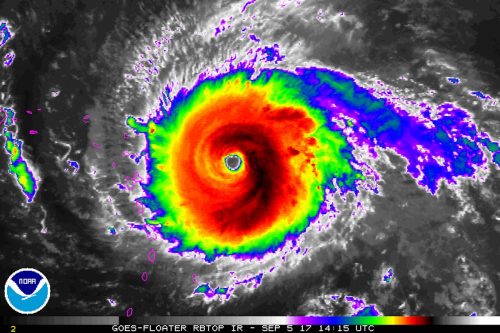
Ready to do it all over again? Fresh on the heels of a $100+ billion hurricane, we very well may be headed for another soon.
As Houston and the Gulf Coast begin a long recovery from Hurricane Harvey, Hurricane Irma is now rampaging through the Atlantic. With 185 m.p.h. sustained winds on Tuesday, Irma became the strongest hurricane in Atlantic history outside of the Caribbean and Gulf. The hurricane made its first landfall early Wednesday in Barbuda and still threatens the Virgin Islands, Puerto Rico, Cuba, and the United States.
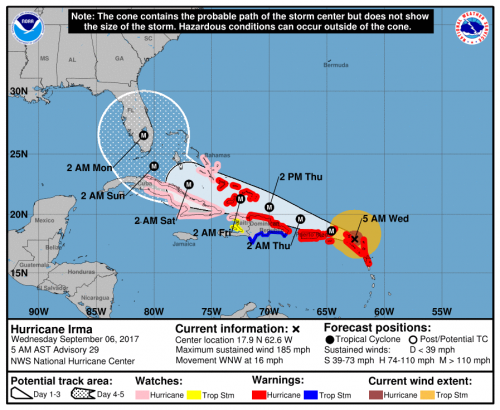
If Irma continues along the general path of 1960’s Hurricane Donna, it could easily tally $50 billion in damage. This estimate, from a study by Karen Clark and Co. (discussed recently on Category 6 Blog), is already four years old (i.e., too low). Increased building costs—which the report notes rise “much faster” than inflation–and continued development could drive recovery costs even higher.
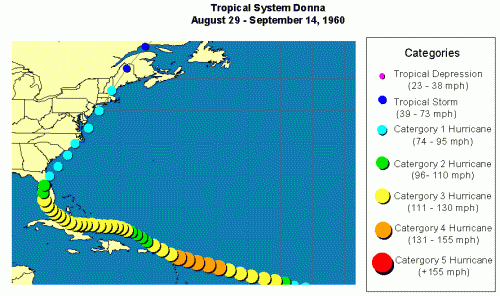
In short, as bad as Houston is suffering, there are do-overs on the horizon—a magnitude of repeated damage costs unthinkable not long ago, before Katrina ($160 million) and Sandy ($70 million).
Repeated megadisasters yield lessons, some of them specific to locale and circumstances. In Miami after Hurricane Andrew, the focus was on building codes as well as the variability of the winds within the storms. After Hurricane Rita, the focus was on improving policies on evacuation. After Hurricane Katrina, while the emergency management community reevaluated its response, the weather community took stock of the whole warnings process. It was frustrating to see that, even with good forecasts, more than a thousand people lost their lives. How could observations and models improve? How could the message be clarified?
Ten years after Katrina, the 2016 AMS Annual Meeting in New Orleans convened a symposium on the lessons of that storm and of the more recent Hurricane Sandy (2012). A number of experts weighed in on progress since 2005. It was clear that challenges remained. Shuyi Chen of the University of Miami, for example, highlighted the need for forecasts of the impacts of weather, not just of the weather itself. She urged the community to base those impacts forecasts on model-produced quantitative uncertainty estimates. She also noted the need for observations to initialize and check models that predict storm surge, which in turn feeds applications for coastal and emergency managers and planners. She noted that such efforts must expand beyond typical meteorological time horizons, incorporating sea level rise and other changes due to climate change.
These life-saving measures are part accomplished and part underway—the sign of a vigorous science enterprise. Weather forecasters continue to hone their craft with so many do-overs. Some mistakes recur. As NOAA social scientist Vankita Brown told the AMS audience about warnings messages at the 2016 Katrina symposium, “Consistency was a problem; not everyone was on the same page.” Katrina presented a classic problem where the intensity of the storm, as measured in the oft-communicated Saffir-Simpson rating, was not the key to catastrophe in New Orleans. Mentioning categories can actually create confusion. And again, in Hurricane Harvey this was part of the problem with conveying the threat of the rainfall, not just the wind or storm surge. Communications expert Gina Eosco noted that talk about Harvey being “downgraded” after landfall drowned out the critical message about floods.
Hurricane Harvey poses lessons that are more fundamental than the warnings process itself and are eerily reminiscent of the Hurricane Katrina experience: There’s the state of coastal wetlands, of infrastructure; of community resilience before emergency help can arrive. Houston, like New Orleans before it, will be considering development practices, concentrations of vulnerable populations, and more. There are no quick fixes.
In short, as AMS Associate Executive Director William Hooke observes, both storms challenge us to meet the same basic requirement:
The lessons of Houston are no different from the lessons of New Orleans. As a nation, we have to give priority to putting Houston and Houstonians, and others, extending from Corpus Christi to Beaumont and Port Arthur, back on their feet. We can’t afford to rebuild just as before. We have to rebuild better.
All of these challenges, simple or complex, stem from an underlying issue that the Weather Channel’s Bryan Norcross emphatically delineated when evaluating the Katrina experience back in 2007 at an AMS Annual Meeting in San Antonio:
This is the bottom line, and I think all of us in this business should think about this: The distance between the National Hurricane Center’s understanding of what’s going to happen in a given community and the general public’s is bigger than ever. What happens every time we have a hurricane—every time–is most people are surprised by what happens. Anybody who’s been through this knows that. People in New Orleans were surprised [by Katrina], people in Miami were surprised by Wilma, people [in Texas] were surprised by Rita, and every one of these storms; but the National Hurricane Center is very rarely surprised. They envision what will happen and indeed something very close to that happens. But when that message gets from their minds to the people’s brains at home, there is a disconnect and that disconnect is increasing. It’s not getting less.
Solve that, and facing the next hurricane, and the next, will get a little easier. The challenge is the same every time, and it is, to a great extent, ours. As Norcross pointed out, “If the public is confused, it’s not their fault.”
Hurricanes Harvey and Katrina caused catastrophic floods for different reasons. Ten years from now we may gather as a weather community and enumerate unique lessons of Harvey’s incredible deluge of rain. But the bottom line will be a common challenge: In Hurricane Harvey, like Katrina, a city’s–indeed, a nation’s–entire way of dealing with the inevitable was exposed. Both New Orleans and Houston were disasters waiting to happen, and neither predicament was a secret.
Meteorologists are constantly getting do-overs, like Irma. Sooner or later, Houston will get one, too.
The Trouble with Harvey: Hurricane Intensification Dilemmas
Hurricanes like rapidly-changing Harvey are still full of surprises for forecasters.
The remnants of Caribbean Tropical Storm Harvey made a startling burst Thursday from a tropical depression with 35 mph winds to an 85 mph hurricane in a little more than 12 hours. It has been moving steadily toward a collision with the middle Texas coast and landfall is later Friday. If intensification continues at the same rate, Harvey is likely to be a major hurricane by then, according to a Thursday afternoon advisory from the National Hurricane Center, with sustained winds of 120-125 mph and even higher gusts.
That’s a big “if.”
The drop in central pressure, which had been precipitous all day—a sign of rapid strengthening—had largely slowed by Thursday afternoon. Harvey’s wind speed jumped 50 mph in fits during the same time, but leveled off by late afternoon at about 85 mph. Harvey was a strong Category 1 hurricane on the Saffir-Simpson Hurricane Wind Scale by dinner time.
The intensifying process then slowed. But it turns out this was temporary.
Many signs pointed to continued rapid intensification: a favorable, low-shear environment; expanding upper-air outflow; and warm sea surface temperatures. Overnight and Friday morning, Harvey continued to traverse an eddy of water with high oceanic heat content that has detached from the warm Gulf of Mexico loop current and drifted westward toward the Texas coast. Its impact is apparent as the pressure resumed its plunge and winds have responded, blowing Friday morning at a steady 110 mph with higher gusts.
Further intensification is possible.
In fact, the SHIPS (Statistical Hurricane Intensity Prediction Scheme) Rapid Intensification indices “are incredibly high,” Hurricane Specialist Robbie Berg wrote in the Thursday morning forecast discussion. Guidance from the model then showed a 70 percent chance of another 50 mph jump in wind speed prior to landfall. The afternoon guidance lowered those odds a bit, but still showed a a 64 percent probability.of a 35 mph increase.
It wouldn’t the first time a hurricane has intensified rapidly so close to the Texas coast. In 1999 Hurricane Bret did it, ramping up to Category 4 intensity with 140 mph winds before crashing into sparsely populated Kennedy County and the extreme northern part of Padre Island.
Hurricane Alicia exploded into a major hurricane just prior to lashing Houston in 1983. And 2007’s Hurricane Humberto crashed ashore losing its warm water energy source and capping its intensity at 90 mph just 19 hours after being designated a tropical depression that morning off the northern Texas Coast, a similar boost in intensity as Hurricane Harvey.
Rapid intensification so close to landfall is a hurricane forecasting nightmare. An abundance of peer-reviewed papers reveal that there’s a lot more we need to learn about tropical cyclone intensity, with more than 20 papers published in AMS journals this year alone. Ongoing research into rapidly intensifying storms like Harvey, is helping solve the scientific puzzle, including recent cases such as Typhoon Megi and Hurricane Patricia. Nonetheless, despite strides in predicting storm motion in past decades, intensification forecasting remains largely an educated guessing game.
Atlantic Hurricane Season Begins
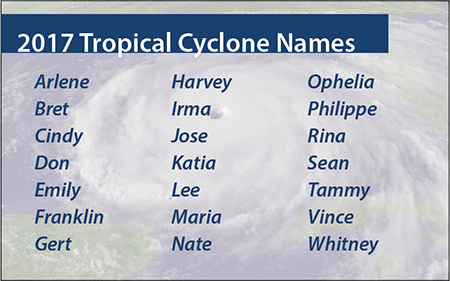 The 2017 Atlantic hurricane season has begun. If they haven’t already, people who could be affected by tropical storms and hurricanes should prepare now for the six-month season, which ends November 30 and encompasses the Atlantic Ocean, Caribbean Sea, and Gulf of Mexico.
The 2017 Atlantic hurricane season has begun. If they haven’t already, people who could be affected by tropical storms and hurricanes should prepare now for the six-month season, which ends November 30 and encompasses the Atlantic Ocean, Caribbean Sea, and Gulf of Mexico.
Here’s what you need to know. Follow the links for more detailed information:
What’s New
Two new products this year will be issued by the National Hurricane Center in addition to the typical tropical storm and hurricane watches, warnings, and advisories:
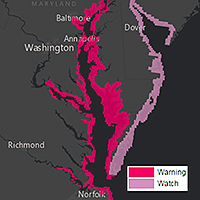 Storm surge watches will be issued within 48 hours of possible life-threatening coastal inundation. Storm surge warnings will be issued at least 36 hours before the danger of life-threatening coastal inundation is realized. The new graphical products will be issued in tandem with NHC’s Potential Storm Surge Flooding Map, which quantifies the expected inundation from storm surge and indicates the depth of the flooding on land.
Storm surge watches will be issued within 48 hours of possible life-threatening coastal inundation. Storm surge warnings will be issued at least 36 hours before the danger of life-threatening coastal inundation is realized. The new graphical products will be issued in tandem with NHC’s Potential Storm Surge Flooding Map, which quantifies the expected inundation from storm surge and indicates the depth of the flooding on land.- Potential tropical storms and hurricanes growing out of disturbances that have not yet become tropical depressions or storms but that pose the threat of bringing tropical storm or hurricane conditions to land areas in 48 hours will be treated as regular storms, with NHC issuing watches, warnings, advisories, and related graphical products as needed.
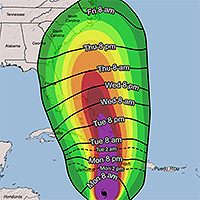 Additionally, NHC will introduce a map to provide guidance on when users should have their preparations completed before a storm. These experimental graphics will show Time of Arrival of Tropical-Storm-Force Winds—a critical planning threshold for coastal communities. Many preparations become difficult or dangerous once tropical storm conditions begin.
Additionally, NHC will introduce a map to provide guidance on when users should have their preparations completed before a storm. These experimental graphics will show Time of Arrival of Tropical-Storm-Force Winds—a critical planning threshold for coastal communities. Many preparations become difficult or dangerous once tropical storm conditions begin.
Prepare
People living in states bordering the Atlantic Ocean and Gulf of Mexico, as well as in The Bahamas, Bermuda, and Caribbean islands, should know that water could be a life-threatening hazard when a hurricane hits. This threat includes storm surge—the sudden rise of seawater at the coast near and to the right of where a hurricane’s center makes landfall. In the United States, hurricane evacuation maps account for the flooding from storm surge and show areas along the coast that people should evacuate if a hurricane threatens. Or it could be from freshwater flooding triggered by a storm’s torrential rain. If either is a risk, make a plan now to leave when threatened.
If water is not a risk, and your area will only face the threat of strong, damaging winds, the official recommendation from the National Hurricane Center is to shelter in place. Meaning, stay put—rather than evacuate. But stay only if your residence is sufficient to weather the storm. Now is the time to prepare your home and property for the possibility of high winds and heavy rain.
Forecasts
A wide variety of academics, private forecasting companies, and the U.S. government issue seasonal hurricane predictions. They generally tend to agree, particularly when a season is expected to be well above or below average. But this year could be a bit different with some predicting fewer tropical storms and hurricanes than is typical in an average year, and others predicting more than the usual numbers of storms and hurricanes. An average Atlantic hurricane season sees a dozen named storms, with a half-dozen of these becoming hurricanes and two going on to become major hurricanes with sustained winds greater than 110 mph.
A quick look at the five longest-running seasonal forecasts for named storms, hurricanes, and major hurricanes, respectively:
- NOAA 11-17, 5-9, 2-4 (midpoints of each range yield 14,7,3) [issued May 25, 2017]
- Colorado State University 14,6,2 [updated June 1, 2017, from 11,4,2]
- The Weather Company 14,7,3 [updated May 22, 2017, from 12,6,2]
- Tropical Storm Risk 14,6,3 [updated May 26, 2017, from 11,4,2]
- Penn State 11-20 named storms with a best estimate of 15 [issued April 25, 2017]
The reason for the low numbers in those forecasts with ranges: there’s uncertainty about whether another El Niño may form midway though the season—El Niño is an anomalous warming of the eastern tropical Pacific that causes air to rise and spread out there, creating wind shear over the Atlantic that inhibits tropical development—as well as whether warmer-than-usual sea surface temperatures in the tropical Atlantic favorable for development will remain that way or cool through the season. Increasing numbers in several forecasts updated since earlier in the spring seem to indicate a lower likelihood of both, although forecasters caution they could reduce the numbers if more than a weak El Niño develops and Atlantic SSTs consequently cool.
Bottom Line
Nearly every weather entity states what Acting FEMA Administrator Robert J. Fenton, Jr. recently expressed after NOAA released its hurricane season forecast last week: “Regardless of how many storms develop this year, it only takes one to disrupt our lives.”
The advice of hurricane forecasters and emergency managers alike is to prepare early and as if this will be the year your neighborhood is hit.
Storm Names
If this year’s list of names the National Hurricane Center will use to keep track of Atlantic storms seems familiar, it’s because it is. NHC made it all the way through this list in the 2005 season. The names of five memorable and deadly hurricanes that year were retired: Dennis, Katrina, Rita, Stan, and Wilma. The updated list was used again in 2011, since NHC rotates through six sets of names, and Irene that year also was retired and replaced.
Time to Lengthen the Official Hurricane Season?
Last week, the fourth named storm—Danielle—of the Atlantic hurricane season formed. It was the earliest such formation in any of the 165 seasons on record. Tropical Storm Colin preceded Danielle just days into the official season, which runs from June 1 through November 30, and was the earliest-on-record third named storm. And Tropical Storm Bonnie formed in May, prior to the season’s start, a pattern that seems to have increased in the past decade.
It makes one wonder: should the official Atlantic hurricane season be lengthened to accommodate the earlier storm formation? The season for Eastern Pacific tropical storms and hurricanes, which form off Mexico’s coast, already does. It runs from May 15 to Nov. 30, and almost like clockwork, the first storm of that season will typically appear midmonth or after.
So the question remains: Is it climate change that necessitates a longer season, or natural variability?
Time to Heed the Hurricane Season Forecast?
With this year’s Atlantic hurricane season getting underway, seasonal forecasts are collectively calling for a quieter-than-usual year in the Atlantic basin, which includes the Caribbean Sea and Gulf of Mexico. With busts in these forecasts as recent as last year, however, is this actually reassuring news?
Mark Powell, a NOAA hurricane researcher who is now working with Florida State University’s Center for Ocean-Atmospheric Prediction Studies, was quoted in a recent Palm Beach Daily News article saying such forecasts, which typically are made before the start of the six-month season, “just don’t have any skill this early.”
They practically don’t. The major players of Atlantic hurricane season forecasts—NOAA, Colorado State University (CSU), and the private British forecasting firm Tropical Storm Risk (TSR)—stipulate that there is only a small increase in skill with pre-season forecasts (i.e., how much better such forecasts are) compared to climatology in foretelling the number of named storms that will form in the Atlantic basin from June 1 to November 30. Supporting this, a talk by Eric Blake of the National Hurricane Center presented at the 29th AMS Conference on Hurricanes and Tropical Meteorology stated that NOAA’s May forecasts for anticipated numbers of storms and hurricanes are only slightly better than what climatology showed had occurred in the previous five seasons. Forecast skill does increase as the season nears its peak months: August, September, and October, which is when 70 percent of tropical storms and hurricanes form.
But even these “better” mid-season forecasts can be wrong. In 2013, early predictions for an active season remained high as September neared, yet the actual number of named storms (13) and especially hurricanes (just 2) fell short of most forecasts, which had been collectively predicting a blockbuster season with at least seven hurricanes and three major hurricanes. The long-term average number of named storms and hurricanes is 12 and 6, respectively. There wasn’t a single major hurricane sporting winds greater than 110 mph last year, when climatology said there should have been at least three. In a blog post at the end of last year’s season, Jeff Masters of WeatherUnderground.com detailed the reason the forecasts failed: the large-scale atmospheric circulation, which can’t be predicted more than a week or two out and isn’t part of seasonal forecasts, was not conducive to tropical cyclone formation.
In 2012, however, it was, and the opposite occurred. The number of named storms peaked at 19—not only well above average but also the third highest number of storms on record in a single season. Ten of these went on to become hurricanes, exceeding most seasonal forecasts including NOAA’s, which had called for an average Atlantic hurricane season prior to its start. CSU had projected in June of that year a relatively quiet hurricane season with 13 named storms and only 5 hurricanes. With twice that many hurricanes forming, the season blew the forecast out of the water, making it CSU’s worst bust in decades of predictions. Until 2013.
This year, however, hurricane season forecasters feel the chance of the development of El Niño by the fall is much higher than it was in 2012—70 percent this summer increasing to 80 percent by fall, according to NOAA’s 9 June El Niño status statement—which lends significant weight to the lower hurricane predictions.
Historically, El Niño stifles Atlantic hurricanes. The enormous slug of warmer-than-normal sea surface temperatures along the Eastern Pacific equator, which defines El Niño, imparts a shift in the atmosphere’s circulation that drives unusually strong winds at high altitudes across the tropical Atlantic Ocean during the season. The induced wind shear—a difference in both speed and direction between the surface and aloft—suppresses not only tropical cyclone development but also formation, tearing apart hurricane seedlings before they can organize.
Research in recent years (Journal of Climate: 2009, 2013), however, has shown that a very different effect can result from El Niño’s half-brother – an anomalous warming in the tropical Pacific that pools in the central rather than the eastern part of the ocean basin. When this occurs, as it did in 2004, it can actually amplify the Atlantic hurricane season. That year, four hurricanes—three of them major, including Charley with 150 mph winds—slammed Florida. There were 15 named storms that year.
No forecasters expect a repeat of the devastating 2004 hurricane season. But, already we’ve had a record eight hurricane seasons without landfall of a major hurricane in the United States nor any category hurricane striking Florida. The last one was Wilma in 2005, which hit as a major hurricane.
Whether or not forecasts are accurate this early in the season, the old adage still applies: it only takes one hurricane in your area to create disaster. So be prepared.
One Year Later, Sandy Still Resonates
The scars from Superstorm Sandy remain evident, even a year after it blasted the North Atlantic coast. In some areas, the cleanup and rebuilding continue in very tangible ways, while for others, the damage cannot simply be repaired with tools and lumber. And while the healing continues, so also does the effort throughout the scientific and emergency planning communities to understand exactly what happened—and to ensure we’re better prepared for the next storm.
At NCAR, scientists have been studying simulations of Sandy in the Advanced Hurricane WRF, NCAR’s hurricane-oriented version of the Weather Research and Forecasting model. Some of their research was discussed at August’s AMS Conference on Mesoscale Meteorology, and a paper detailing their work will be published shortly in Monthly Weather Review. Their key finding was that Sandy combined elements of many familiar phenomena that “hadn’t been previously shown to come together in such a way near a major coastline,” according to NCAR’s Bob Henson, who detailed the findings in this article. He wrote:
Strong winter storms at sea sometimes develop pockets of warm air within their cold cores—a process known as warm seclusion, first characterized by Shapiro and Daniel Keyser. However, in this case, the warm air being secluded was already present in Sandy’s inner core. This is the first time such a dramatic warm seclusion has been documented in a landfalling U.S. hurricane.
While Superstorm Sandy was a highly unusual phenomenon from a scientific standpoint, it also presented new and unique challenges in other ways; for example, its path through the northeast United States took it through heavily populated–and in some cases, particularly vulnerable–areas. Sandy’s impact on the built environment makes it an especially appropriate example of the theme of the 2014 AMS Annual Meeting in Atlanta. During that meeting, the lessons that Sandy reveals about future extreme events will be explored at a special conference titled “Superstorm Sandy and the Built Environment: New Perspectives, Opportunities and Tools.” This conference will focus on three complementary elements of the storm: prediction and preparedness; response and recovery; and, particularly, new perspectives, opportunities, tools, and imperatives for the future built environment. The broad range of topics to be discussed include storm evolution and prediction; communication about the storm through the media; impacts on lives, property, and infrastructure; and preparation and response. The complete schedule for the conference can be found here.
New AMS Book Remembers the Great New England Hurricane
It has been known by many names: the Yankee Clipper, the Great New England Hurricane, the Long Island Express . . . or simply the New England Hurricane of 1938. With fatalities estimated at between 500 and 700, it’s still the deadliest hurricane in modern New England history, and only Sandy last year was more costly (property damage from the ’38 storm amounted to almost $5 billion in 2013 dollars). Tomorrow is the 75th anniversary of the storm’s landfall as a Category 3 hurricane on Long Island, and to coincide with that occasion, the AMS has just released a new book about the event: Taken by Storm, 1938: A Social and Meteorological History of the Great New England Hurricane, by Lourdes B. Avilés. (To order the book, visit the AMS bookstore.) The first book to detail the science of the storm, it also delves into the Great Hurricane’s significant societal impacts. In the preface, Avilés discusses her motivation for writing the book:
My goal has not been to retell the story that has already been told, although there has to be some of that too, but to take a somewhat interdisciplinary approach to weaving together different aspects–different stories–of the 1938 Hurricane. This includes what happened before, during, and after the event, in the context of the meteorological history of the storm and its associated destruction and devastation; casualties, survival, and recovery in the affected population; environmental and geological changes caused by the storm; the science of hurricanes and of early-20th-century meteorology; and, finally, the added perspective of other intense hurricanes that have affected and no doubt will again affect the region.
AMS Director of Publications Ken Heideman, who wrote the foreword to Taken by Storm, 1938, recently talked to Avilés about the hurricane and her new book; the complete interview is below.
A New Metric for Hurricane Destruction Potential
Hurricanes Katrina (2005), Ike (2008), and Sandy (2012) have proven the Saffir-Simpson Scale is inadequate for expressing hurricane destructiveness. This is especially true for storm surge, which the original Category 1-5 wind damage potential rating scale wasn’t designed to classify.
As another Atlantic hurricane season begins, a study now accepted for publication in Monthly Weather Review introduces a new metric for measuring the destructive potential of tropical cyclones: Track Integrated Kinetic Energy. TIKE builds on the earlier concept of Integrated Kinetic Energy to represent destructive potential by computing a storm’s sustained wind field quadrant-by-quadrant along its entire track. Summing up the IKE values over the tropical cyclone’s lifecycle more accurately determines the potential for destruction, the study concludes.
Additionally, TIKE can be accumulated for all of a tropical cyclone basin’s storms in a given year to create “an important metric of that season,” the authors write in a summary of their research (to appear in an upcoming issue of the Bulletin of the AMS).
Vasu Misra, lead author of the study “The Track Integrated Kinetic Energy of the Atlantic Tropical Cyclones,” adds:
Existing metrics such as Accumulated Cyclone Energy (ACE) or the Power Dissipation Index (PDI) only consider the peak wind in the storm, which is difficult to measure and typically only covers a very small area and contributes little to storm surge and wave damage. TIKE takes into account the wind forcing over a large area surrounding the storm and is therefore much more reliable as an objective measure of hurricane destructive potential. In effect TIKE accounts for the intensity, duration, size, and structure of the tropical cyclones.
The study by Misra and his colleagues also looks at seasonal and season-to-season as well geographic variations of TIKE. Among its findings:
- TIKE peaks in September along with hurricane season overall, since that’s when the Atlantic Ocean is warm enough to fuel large and long-lived storms;
- Very active hurricane seasons such as 2005 may not be the most destructive since some large and powerful hurricanes may be short-lived;
- Annual variations in TIKE are related to sea surface temperature variations in both the equatorial Pacific (warmer temperatures there relate to lower TIKE in the Atlantic) and the Atlantic (its warmer temperatures relate to higher TIKE there).
The MWR article abstract is open to all readers, while subscribers can read the full Early Online Release on the AMS journals website.